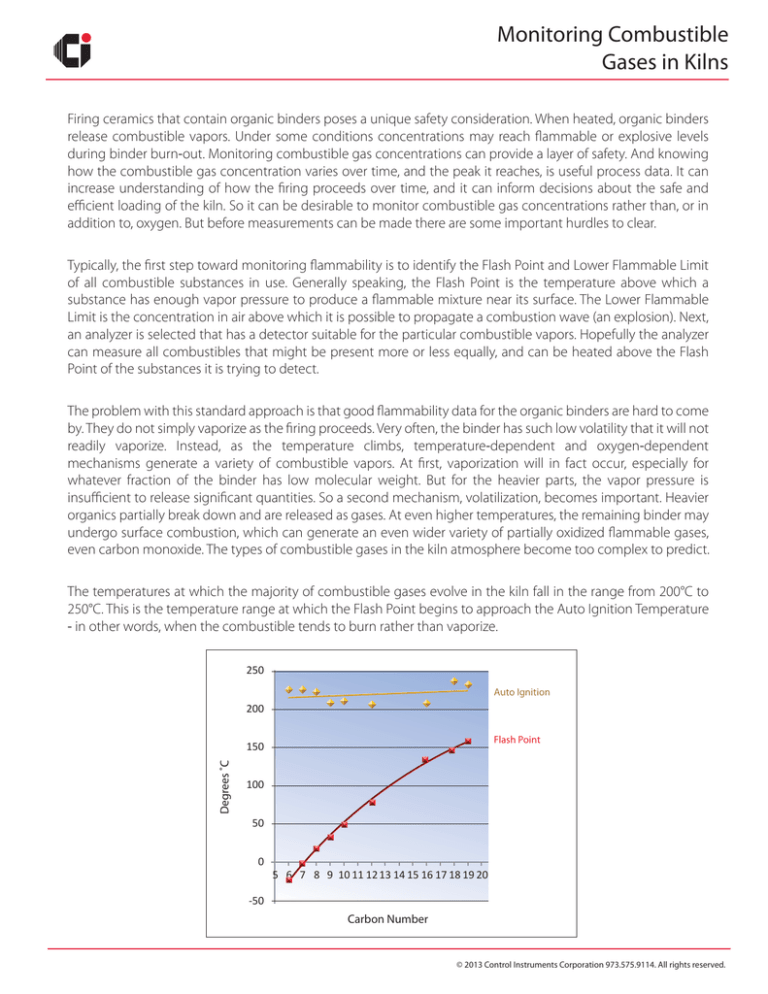
Monitoring Combustible
Gases in Kilns
Firing ceramics that contain organic binders poses a unique safety consideration. When heated, organic binders
release combustible vapors. Under some conditions concentrations may reach flammable or explosive levels
during binder burn‐out. Monitoring combustible gas concentrations can provide a layer of safety. And knowing
how the combustible gas concentration varies over time, and the peak it reaches, is useful process data. It can
increase understanding of how the firing proceeds over time, and it can inform decisions about the safe and
efficient loading of the kiln. So it can be desirable to monitor combustible gas concentrations rather than, or in
addition to, oxygen. But before measurements can be made there are some important hurdles to clear.
Typically, the first step toward monitoring flammability is to identify the Flash Point and Lower Flammable Limit
of all combustible substances in use. Generally speaking, the Flash Point is the temperature above which a
substance has enough vapor pressure to produce a flammable mixture near its surface. The Lower Flammable
Limit is the concentration in air above which it is possible to propagate a combustion wave (an explosion). Next,
an analyzer is selected that has a detector suitable for the particular combustible vapors. Hopefully the analyzer
can measure all combustibles that might be present more or less equally, and can be heated above the Flash
Point of the substances it is trying to detect.
The problem with this standard approach is that good flammability data for the organic binders are hard to come
by. They do not simply vaporize as the firing proceeds. Very often, the binder has such low volatility that it will not
readily vaporize. Instead, as the temperature climbs, temperature‐dependent and oxygen‐dependent
mechanisms generate a variety of combustible vapors. At first, vaporization will in fact occur, especially for
whatever fraction of the binder has low molecular weight. But for the heavier parts, the vapor pressure is
insufficient to release significant quantities. So a second mechanism, volatilization, becomes important. Heavier
organics partially break down and are released as gases. At even higher temperatures, the remaining binder may
undergo surface combustion, which can generate an even wider variety of partially oxidized flammable gases,
even carbon monoxide. The types of combustible gases in the kiln atmosphere become too complex to predict.
The temperatures at which the majority of combustible gases evolve in the kiln fall in the range from 200°C to
250°C. This is the temperature range at which the Flash Point begins to approach the Auto Ignition Temperature
‐ in other words, when the combustible tends to burn rather than vaporize.
250
Auto Ignition
200
Flash Point
Degrees ˚C
150
100
50
0
5 6 7 8 9 10 11 12 13 14 15 16 17 18 19 20
-50
Carbon Number
© 2013 Control Instruments Corporation 973.575.9114. All rights reserved.
Monitoring Combustible
Gases in Kilns
Some important features of an analyzer are therefore clear. Ideally, an analyzer should have a broad response to
all combustibles, a uniform sensitivity to each and every one, and the ability to operate at 250°C or more. A
detector that responds only to a specific combustible gas, or that varies too much for different gases, cannot be
properly calibrated and so cannot be made accurate. Sample conditioning cannot be performed if it involves a
decrease in temperature, since filtering out the resulting condensate will also remove the combustibles from the
sample stream and produce false low readings.
Selection of an analyzer for monitoring kilns leads either to a flame ionization or flame temperature detector.
Non‐dispersive infrared sensors are limited in operating temperature and cannot be accurately applied to the
broad range of combustibles found in kilns. The two detector types most likely to produce a satisfactory response
both use a sensing flame. Of these two, the flame temperature type is preferred for its ability to also detect
non‐hydrocarbon substances such as carbon monoxide and hydrogen, which are not detected by flame
ionization.
Some things to consider when monitoring combustible gases in a kiln:
Heating all sample‐wetted parts of the analyzer and sampling system to 250°C will prevent condensation.
The sample stays intact. The measurement includes all combustible vapors.
Sample pumps cannot provide the same level of reliability as an aspirated sampling system and should be
avoided.
A flame‐based detector has the best chance to measure the wide range of combustible vapors that might be
present. A flame temperature type will include the widest possible range of combustible gases and vapors,
including non‐hydrocarbons such as hydrogen and carbon monoxide.
Flammability data for organic binders may be difficult to obtain. A rough estimate for the Lower Flammable
Limit in air is 50% of stoichiometric. Another useful rough estimate is one pound of binder per 340 standard
cubic feet of air (50 grams per normal cubic meter)
Near the Flash Point, the vapor pressure tends to double for every 10°C rise in temperature. Small changes in
temperature can have a large effect. Cooling the sample a bit can condense out half the combustibles.
© 2013 Control Instruments Corporation 973.575.9114. All rights reserved.


